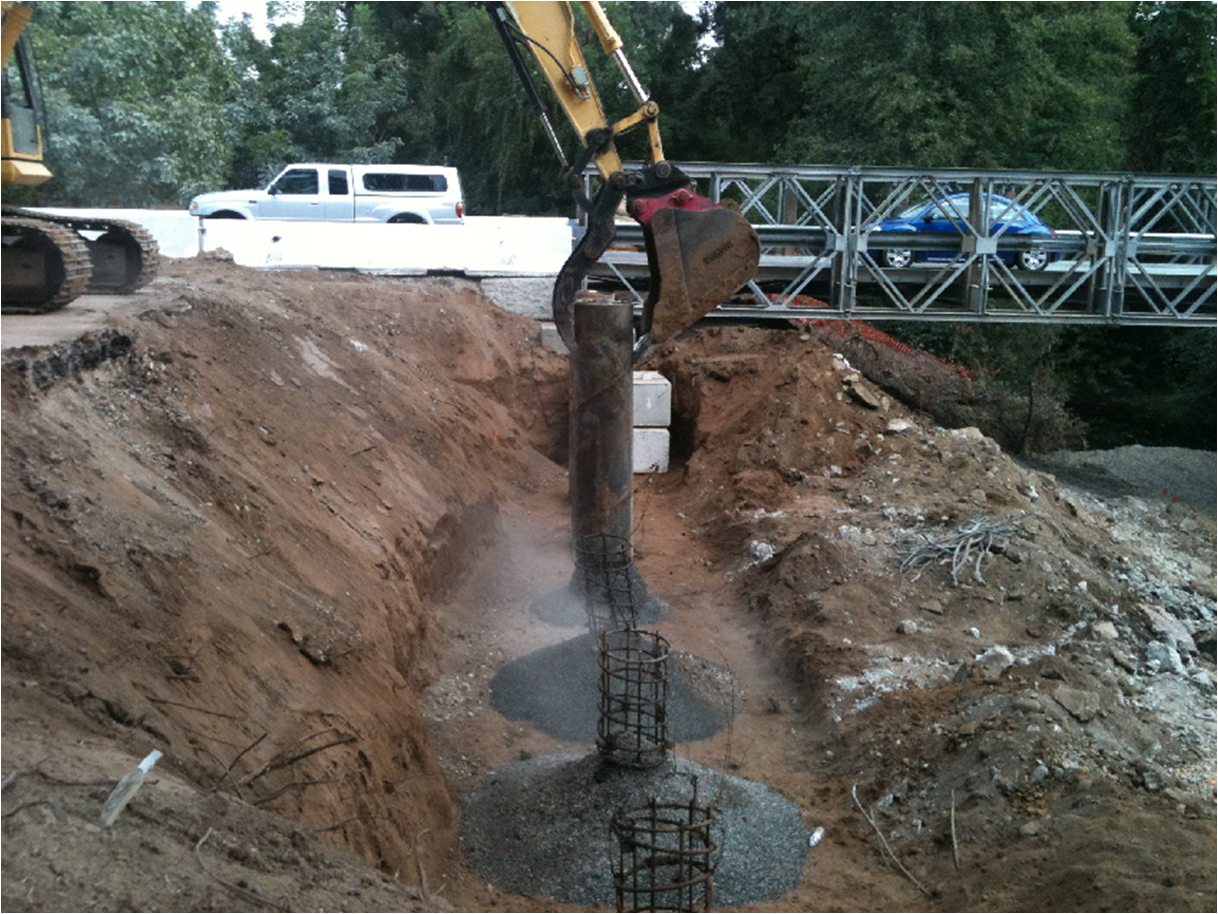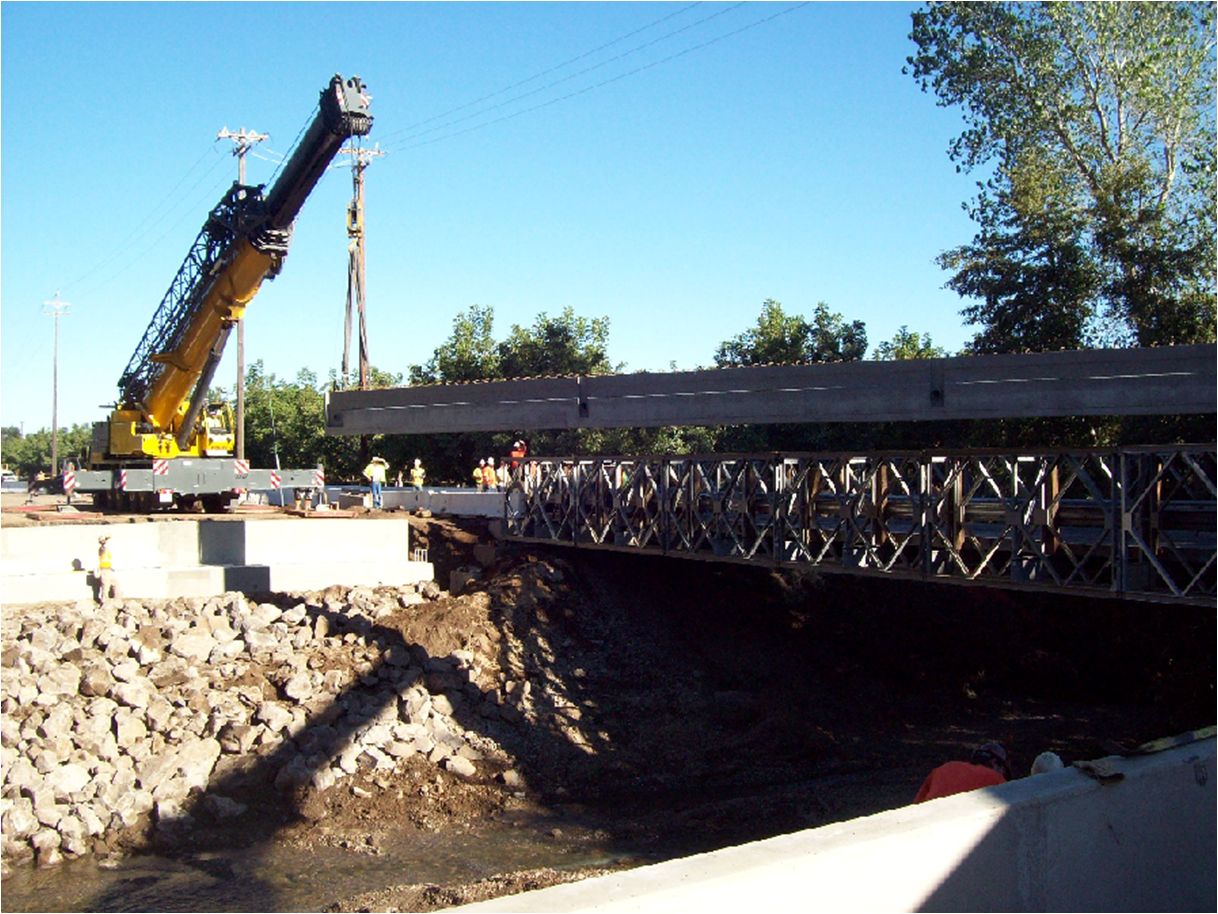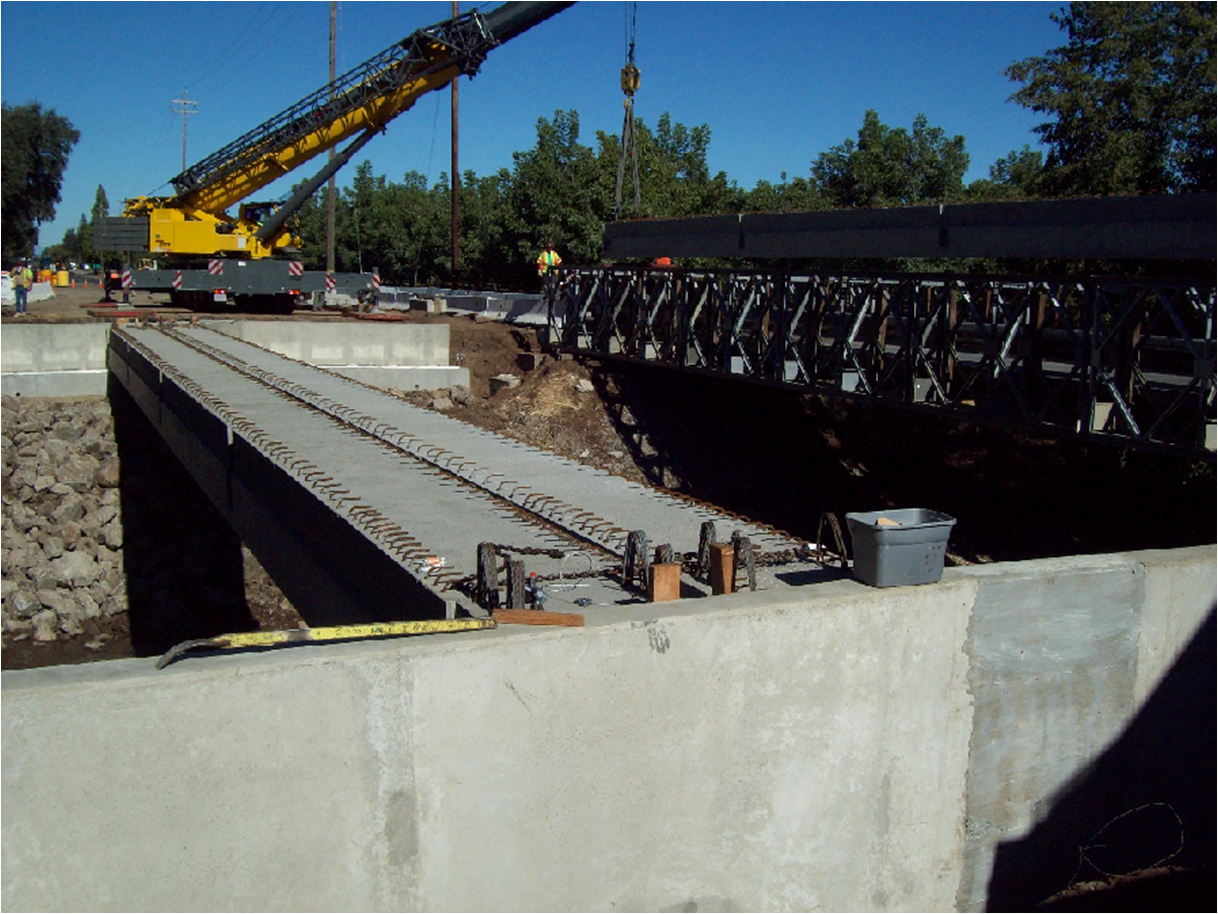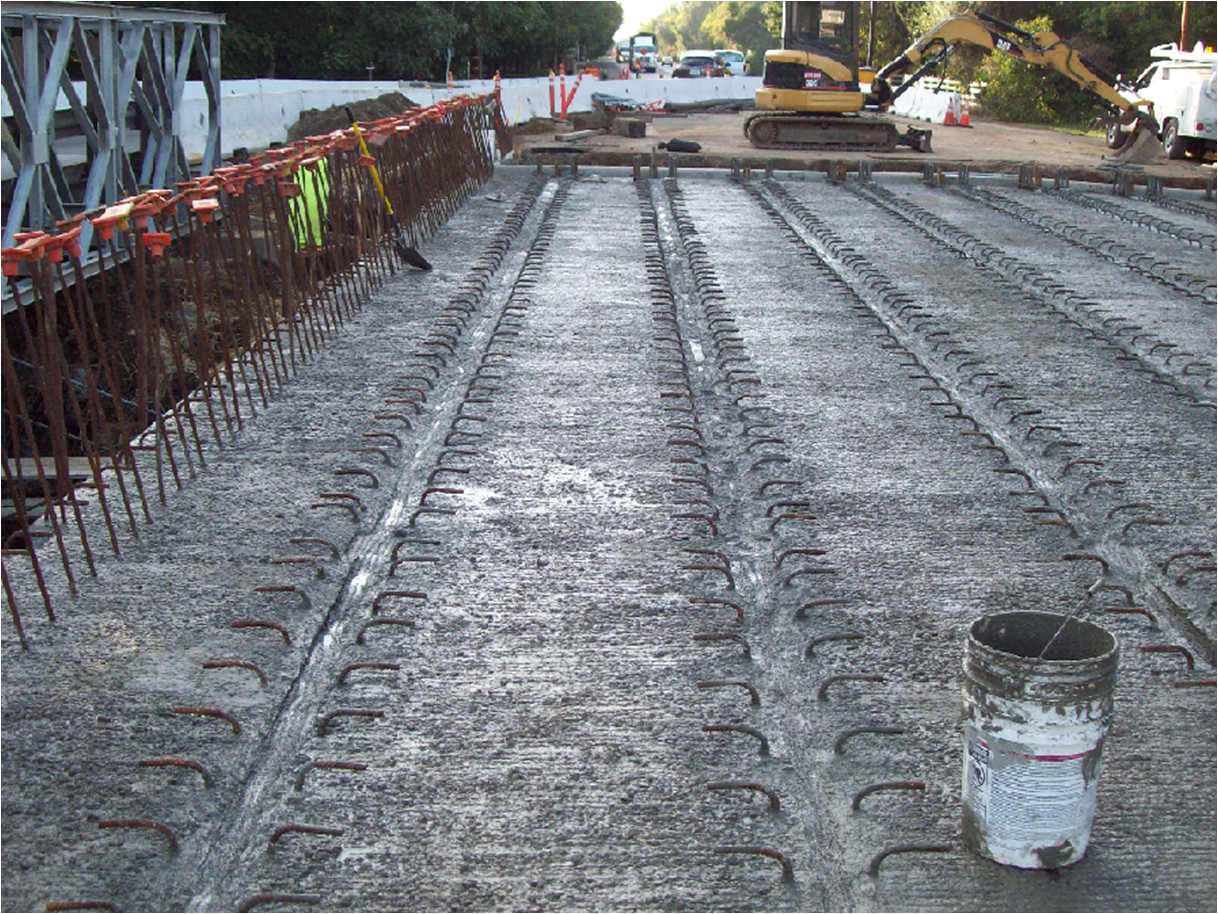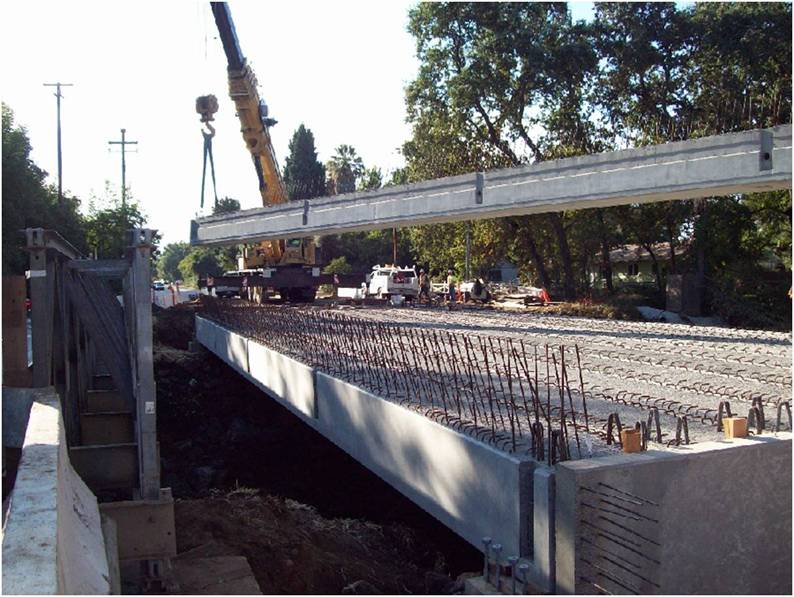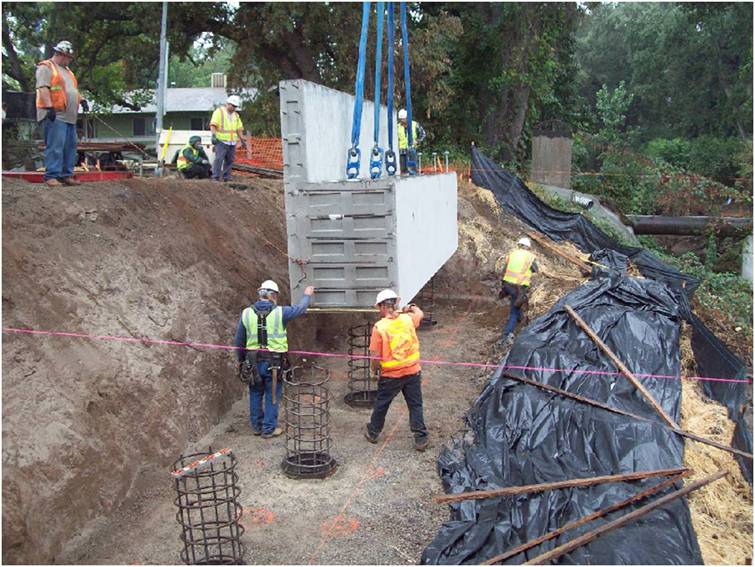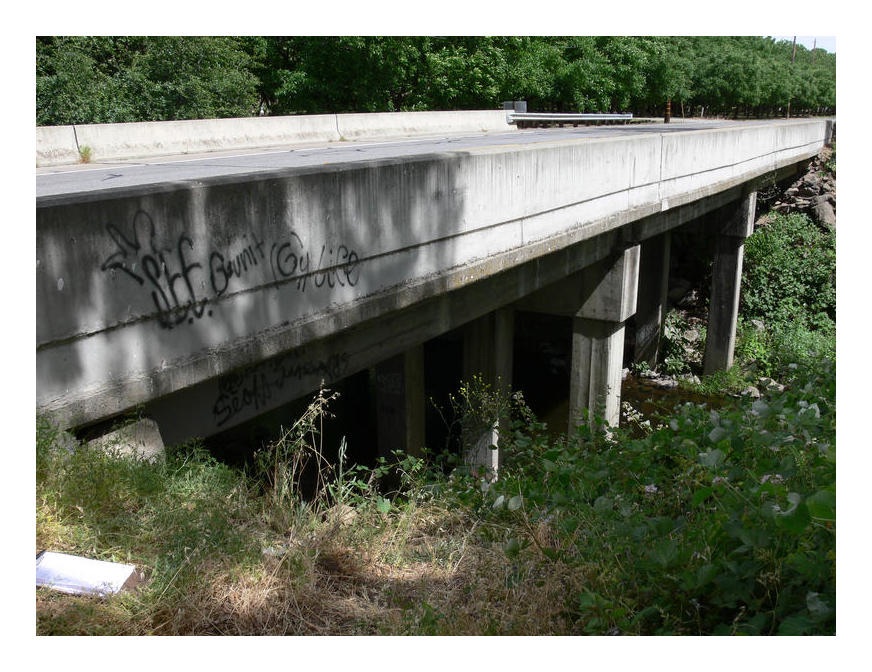State: CA
County: Tehama
Owner: State
Location: Rural
Spans: One-span
Beam material: Concrete
Max Span Length (ft.): 108
Total Bridge Length (ft.): 108
Construction Equipment Category: Conventional
ABC Construction Equipment: Conventional
State ID Number: 08-0168
NBI Number:
Coordinates
Latitude: 40.147553 | Longitude: -122.137856
Bridge Description
Project Summary:29-calendar-day bridge replacement of scour-damaged bridge.
Project Location:
State Route 99 over Craig Creek near Los Molinos in northern California
Impact Category:
Tier 4 (within 1 month)
Mobility Impact Time:
ABC: 29 calendar days
Conventional: 3 months
Primary Drivers:
reduced traffic impacts; reduced onsite construction time; improved site constructability; improved material quality and product durability; minimized environmental impacts
Dimensions:
108-ft long and 44-ft wide single-span precast adjacent box beam bridge
Average Daily Traffic (at time of construction):
100
Traffic Management (if constructed conventionally):
Traffic management alternative, if constructed conventionally: 3-month use of two-stage construction with signalized one-lane traffic control
Existing Bridge Description:
The existing three-span reinforced concrete bridge was 89.5 ft long and 42.33 ft wide with pile extension substructure. The bridge had scour damage and required replacement.
Replacement or New Bridge:
The replacement bridge has two 12-ft-wide traffic lanes, a 9-ft-wide shoulder, and an 8-ft-wide shoulder. The cross-section consists of eleven 4-ft-wide 3.5-ft-deep abutting precast box beams with a 5-inch-thick 4000-psi cast-in-place reinforced concrete deck. The precast abutments were founded on cast-in-steel shell (CISS) piles.
Construction Method:
The contractor drove the CISS piles and paved over them in the fall of 2010, with work then stopped due to contract administration issues.
In the fall of 2011 the contractor launched a temporary bridge and detoured traffic onto the temporary bridge. The existing bridge was closed and demolished. Abutments were excavated. The precast abutment caps with backwalls were erected over the CISS piles, the abutment segment closure joints were cast, and the cap pockets were filled with concrete. After the abutment closure joint and cap pocket concrete was cured, the precast box beams were set on elastomeric bearing pads. Abutment backfill was placed. The transverse tie rods in ducts at mid-depth of the beams were stressed to 20 percent, and the shear keys between the beams were grouted. After the grout cured, the transverse tie rods were fully stressed. The high-performance concrete (HPC) deck was constructed, and the transverse ducts in the beams were grouted. The deck was cured. Temporary barriers were placed to protect crews constructing the cast-in-place traffic railing, and the bridge was re-opened to traffic. Diamond drum grinding was completed several weeks after the bridge was re-opened to traffic to improve ride quality and reduce tire noise. No deck overlay was applied; Caltrans plans to apply a methacrylate deck treatment if cracks appear in the deck.
The temporary bridge was delivered to the site on September 14, launched September 15, and was open to traffic beginning September 26. The old bridge was demolished and the replacement bridge was constructed, with deck concrete placed October 20 and the bridge opened to traffic four days later on October 24. The temporary bridge was shipped out October 27.
The bridge was originally designed for two-stage construction but was changed post-bid through a Value Engineering Cost Proposal Change Order by the contractor, to be built in a single-stage with the use of a flagger-controlled single-lane temporary Mabey bridge detour. The contract restricted access in Craig Creek from July 15 to October 15. No incentives or disincentives were included in the contract.
Stakeholder Feedback:
This project included research on accelerated bridge deck construction procedures. The cast-in-place concrete deck used an early-strength-gain mix design to reduce construction duration and included a shrinkage-reducing admixture to counter long-term drying shrinkage. Also, synthetic fiber reinforcement was included to reduce plastic cracking and improve longer-term crack control, and an additional quarter-inch (sacrificial) thickness was allowed for subsequent diamond drum grinding. In addition, a faster and improved curing method was used to reduce construction duration; in this method the water curing time was reduced to three days followed by a second heavy application of spray-on curing compound.
Craig Creek was the second Caltrans project to employ precast abutments and the first to divide the abutments into multiples sections to improve transport and constructability. Now that the efficacy of this approach has been established, the use of precast abutments can be considered a “new normal” for EDC applications. Caltrans will be issuing contract documents for ABC projects with a special awareness logo alerting subcontractors and suppliers to the fast tempo and commensurate attention required in construction. In addition, Caltrans will continue to monitor the deck performance at Craig Creek. Assuming the deck continues to perform well the HPC methods for deck concrete along with the innovative mix design to control cracking will be applied to future projects.
High Performance Material:
High-performance concrete (HPC) cast-in-place deck
Project Planning
Decision Making Tools:Site Procurement:
Project Delivery: Design-bid-build
Contracting: Full lane closure, Value Engineering
Geotechnical Solutions
Foundations & Walls:Rapid Embankment:
Structural Solutions
Prefabricated Bridge Elements: Adjacent box beams, Precast abutment cap w/backwall, Precast wingwallsPrefabricated Bridge Systems:
Miscellaneous Prefabricated: CIP reinforced closure joints, Grouted key closure joint, PT ducts/bonded, Pocket connection (in precast substructure)
Costs & Funding
Costs:The engineer’s estimate for the bridge portion of the project was $1.379 million. The low bid was $998,000 ($381,000 = 28% lower than the engineer’s estimate). There were nine bidders.
The signalized-control delay costs to the traveling public were calculated at $7,800 per day. For the initially-planned staged construction duration of 40 days, this would have totaled $312,000. Due to the late award, this delay cost would have been over $2.4 million had the contractor proceeded with half-width construction and a winter suspension.
Funding Source:
Federal and State
Incentive Program:
Additional Information
Caltrans Accelerated Bridge Construction Manual
Downloadable Resources
Contract Plans: View Craig-Creek-Bridge-Plans.pdf
Bid Tabs:
View Bid-Tabs-CraigCreek-02-2C1104A-2526.pdf
View Craig-Creek-ABC-partial-schedule.pdf
Other Related Information:
Other Related URLs:
Go to:
Caltrans Division of Engineering Services
California Department of Transportation
Contacts
Owner:
Sonny Fereira, P.E.
Area Bridge Engineer
California Department of Transportation
sonny_fereira@dot.ca.gov
530-949-2529



